Characteristics
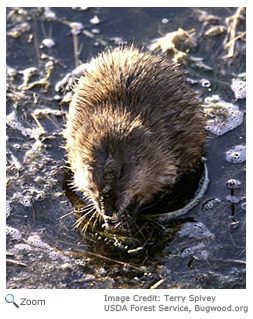 The muskrat is a large rodent that is is about a foot to two feet long. It has a stocky body, a rounded head and a long, scaly black tail that is 7 to 12 inches long. Its tail is
laterally flattened, that means it is flattened vertically! Its tail
works like a rudder and helps the muskrat maneuver in the water! It has thick, soft, glossy, reddish-brown to dark brown fur on its uppersides and paler fur on its undersides. It has a thick coat of fur under its guard fur that is waterproof. It may also have a white patch of fur under its chin and a darker patch of fur on its nose. The muskrat has small eyes and tiny ears. It has short legs and small front feet. Its rear feet are larger and slightly webbed. It gets its name from the two musk glands on its rear under its tail. The muskrat is a large rodent that is is about a foot to two feet long. It has a stocky body, a rounded head and a long, scaly black tail that is 7 to 12 inches long. Its tail is
laterally flattened, that means it is flattened vertically! Its tail
works like a rudder and helps the muskrat maneuver in the water! It has thick, soft, glossy, reddish-brown to dark brown fur on its uppersides and paler fur on its undersides. It has a thick coat of fur under its guard fur that is waterproof. It may also have a white patch of fur under its chin and a darker patch of fur on its nose. The muskrat has small eyes and tiny ears. It has short legs and small front feet. Its rear feet are larger and slightly webbed. It gets its name from the two musk glands on its rear under its tail.
Range
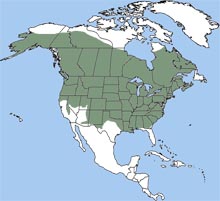 The muskrat is found from northern North America south to the Mexican border. It is not found in parts of California, Florida, and Texas. It is found throughout New Hampshire. The muskrat is found from northern North America south to the Mexican border. It is not found in parts of California, Florida, and Texas. It is found throughout New Hampshire.
Habitat
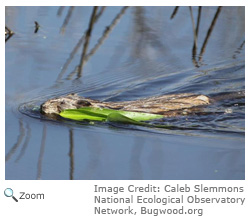 The muskrat is found in swamps, marshes, rivers, ponds, lakes, drainage ditches and canals. It prefers an environment with four to six feet of still or slow-moving water and plants like cattails,
pondweeds, bulrushes and sedges. It needs open travel channels in the water so it can move around easily. In marsh environments, the muskrat builds a dome-shaped lodge of plants. The lodge can be five feet across and four feet high and has an inner chamber with more than one underwater entry hole. In some cases, the muskrat may build separate lodges for feeding and nesting! In other habitats like rivers, creeks, drainage ditches and canals, the muskrat creates a bank burrow for shelter. The burrow consists of a tunnel and a nesting chamber. There is usually an underwater entrance to the burrow. The muskrat is found in swamps, marshes, rivers, ponds, lakes, drainage ditches and canals. It prefers an environment with four to six feet of still or slow-moving water and plants like cattails,
pondweeds, bulrushes and sedges. It needs open travel channels in the water so it can move around easily. In marsh environments, the muskrat builds a dome-shaped lodge of plants. The lodge can be five feet across and four feet high and has an inner chamber with more than one underwater entry hole. In some cases, the muskrat may build separate lodges for feeding and nesting! In other habitats like rivers, creeks, drainage ditches and canals, the muskrat creates a bank burrow for shelter. The burrow consists of a tunnel and a nesting chamber. There is usually an underwater entrance to the burrow.
|
|
Diet
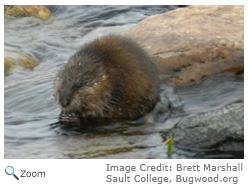 The muskrat can close its mouth around its protruding teeth and chew underwater! The muskrat eats aquatic vegetation like
cattails, sedges, rushes, water lilies and pond weeds. In some areas it also eats clams,
mussels, snails, crayfish, small fish and frogs. The muskrat doesn't eat its food where it finds it, it usually drags its food out to a feeding platform in the water or a feeding station near one of its travel paths. These feeding platforms are made of mud and vegetation. It can then eat its food without worrying about predators! The muskrat is
crepuscular, that means it is most active at dawn, dusk and at night. The muskrat can close its mouth around its protruding teeth and chew underwater! The muskrat eats aquatic vegetation like
cattails, sedges, rushes, water lilies and pond weeds. In some areas it also eats clams,
mussels, snails, crayfish, small fish and frogs. The muskrat doesn't eat its food where it finds it, it usually drags its food out to a feeding platform in the water or a feeding station near one of its travel paths. These feeding platforms are made of mud and vegetation. It can then eat its food without worrying about predators! The muskrat is
crepuscular, that means it is most active at dawn, dusk and at night.
Life Cycle
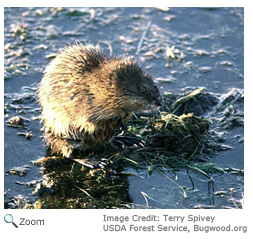 In the southern part of its range the muskrat may breed year-round. In the northern parts of its range mating season runs from March through August. The female muskrat may have up to five litters a year. Male muskrats compete for females. The female gives birth to two to nine young. The young are covered with fur at birth and their eyes are closed. They can swim when they are about ten days old and begin to eat vegetation when they are about 20 days old. They are fully weaned when they are about a month old. They leave their mother after weaning and establish their own territory. They mate when they are about a year old. The average lifespan of a muskrat in the wild is three or four years. In the southern part of its range the muskrat may breed year-round. In the northern parts of its range mating season runs from March through August. The female muskrat may have up to five litters a year. Male muskrats compete for females. The female gives birth to two to nine young. The young are covered with fur at birth and their eyes are closed. They can swim when they are about ten days old and begin to eat vegetation when they are about 20 days old. They are fully weaned when they are about a month old. They leave their mother after weaning and establish their own territory. They mate when they are about a year old. The average lifespan of a muskrat in the wild is three or four years.
Behavior
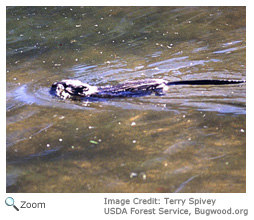 The muskrat is a very good swimmer and can stay underwater for as long as 15 minutes. It uses its tail and webbed feet to propel itself through the water and can swim both forwards and backwards! The muskrat is a very good swimmer and can stay underwater for as long as 15 minutes. It uses its tail and webbed feet to propel itself through the water and can swim both forwards and backwards!
|